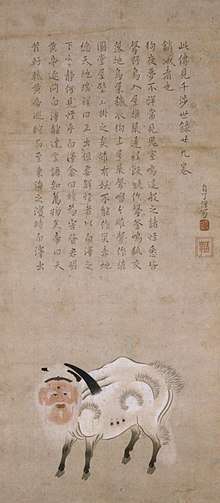Bai Ze
Baí Zé (simplified Chinese: 白泽; traditional Chinese: 白澤; pinyin: Baízé; Wade–Giles: Pai-tse), or hakutaku (白澤) in Japanese, is a mythical beast from Chinese legend. Its name literally means "white marsh".

The Baí Zé was encountered by the Yellow Emperor or Huáng Dì while he was on patrol in the east. Thereafter the creature dictated to Huáng Dì a guide to the forms and habits of all 11,520 types of supernatural creatures in the world, and how to overcome their hauntings and attacks. The emperor had this information written down in a book called the Bái Zé Tú (白泽图/白澤圖). This book no longer exists, but many fragments of it survive in other texts.
In Japan
According to legend, a creature called kutabe, thought to be identical to the Bai Ze of China, once appeared on Mount Tatesan in Toyama Prefecture and "predicted that a deadly plague would sweep through in the next few years. The beast prescribed that its own image be used as a talisman to ward off the disease, and since then the hakutaku has been worshipped as a guardian spirit of herbal medicine."
The common Japanese image generally depicts the hakutaku as a "bovine or monstrous felid creature with nine eyes and six horns, arranged in sets of three and two on both its flanks and its man-like face. It is also commonly depicted as having the body of a lion and eight eyes, known for having a horn or multiple horns on their heads." However, the number of extra eyes actually varies depending on interpretation, and sometimes the creature is pictured with only one in the center of its head. It is considered to be "intelligent, and well read with the ability to understand human speech."
In Zen and Japanese Culture, D. T. Suzuki describes the hakutaku as "a mythical creature whose body resembles a hand and whose head is human. It was anciently believed that the creature ate our bad dreams and evil experiences, and for this reason, people, wishing it to eat up all the ills which we are likely to suffer, used to hang its picture on the entrance gate or inside the house."
References
- Harper, Donald (December 1985). "A Chinese Demonography of the Third Century B.C.". Harvard Journal of Asiatic Studies. Harvard-Yenching Institute. 45 (2): 491–492. doi:10.2307/2718970. JSTOR 2718970.
- Mizuki, Shigeru (2004). Mujara 6: Sekai, Tokubetsu-hen (in Japanese). Japan: Soft Garage. p. 31. ISBN 4-86133-030-0.
- Mizuki, Shigeru (2003). Mujara 6: Chūbu-hen (in Japanese). Japan: Soft Garage. p. 60. ISBN 4-86133-005-X.
- Suzuki, Daisetz Teitarō (2010). Zen and Japanese Culture. US: Princeton. p. 168. ISBN 978-0-691-14462-7.